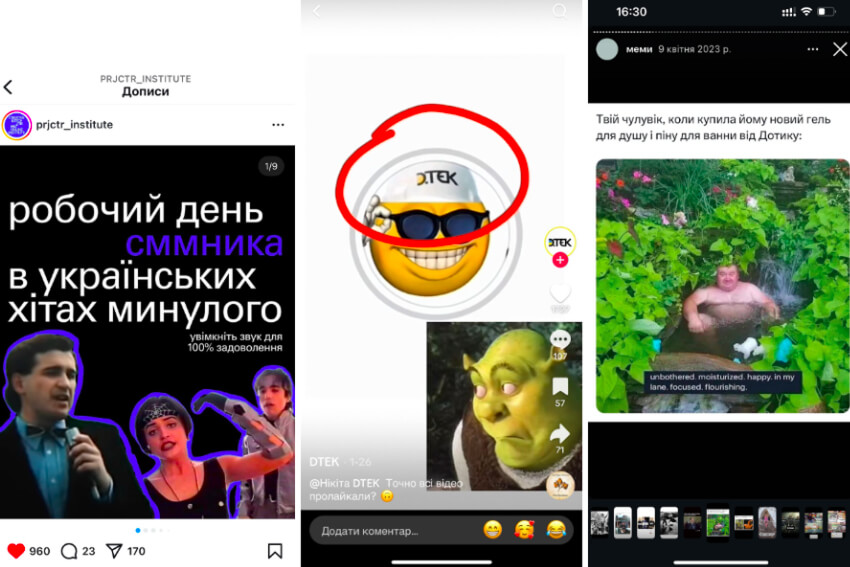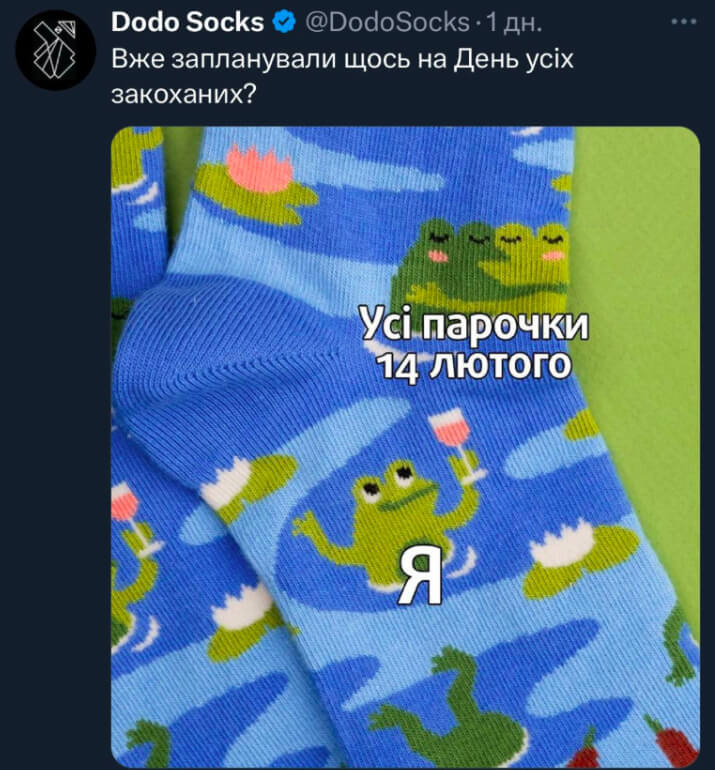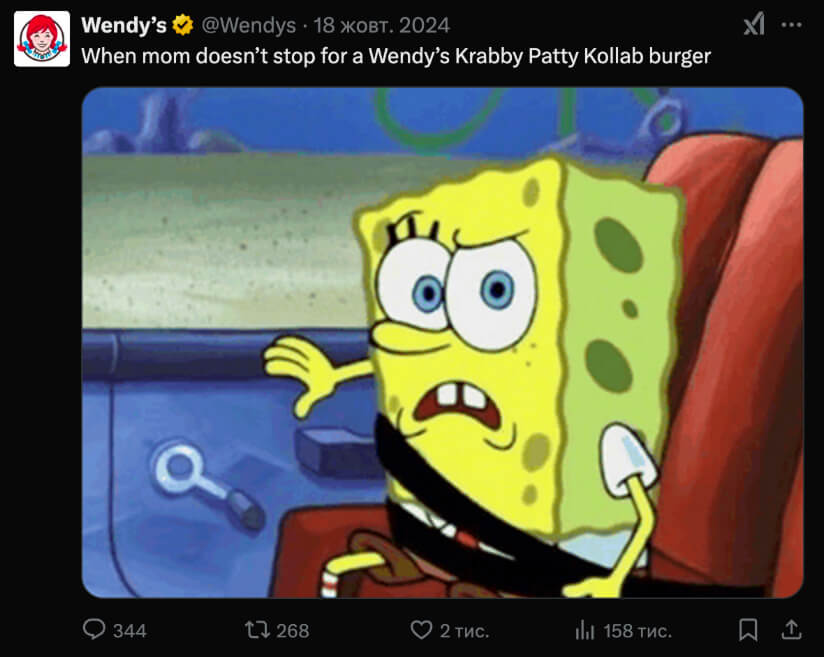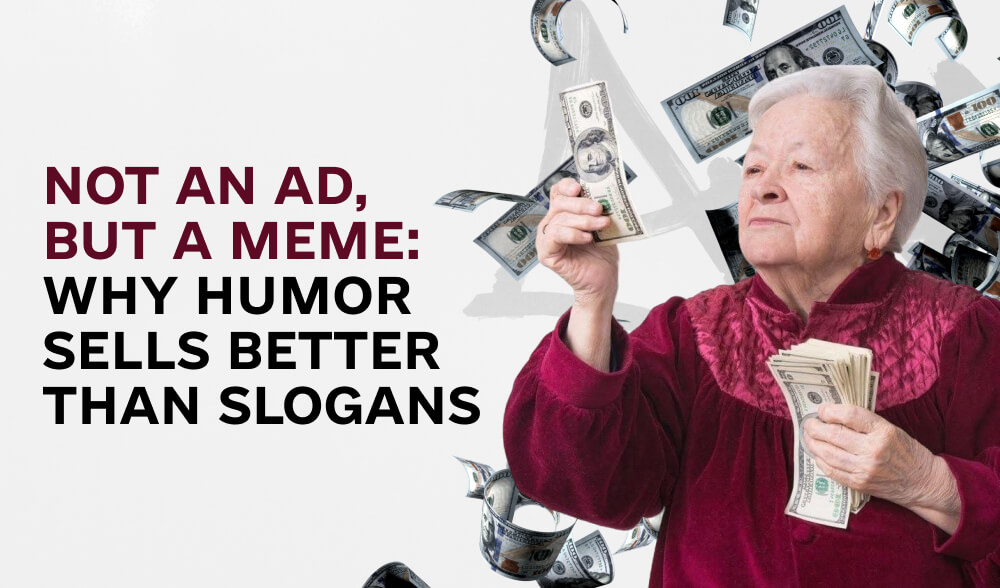What is meme marketing?
If a few years ago memes were just entertainment shared by friends, now they have become a full-fledged marketing tool. And it’s not surprising – people are tired of banal advertising slogans and standard “buy from us” posts. But if a brand enters social media with humor and light self-irony, it quickly becomes closer to its audience.
The essence of meme marketing is quite simple: a company creates or adapts memes related to its product or services and publishes them on social media. The main thing is to do it in such a way that it doesn’t look like you’re being sold something, but rather that it is sincere, witty, and evokes a “yeah, that’s me.”
Imagine the situation: you’re flipping through your Instagram or TikTok feed and a standard ad pops up – “Our shampoo will make your hair perfect.” Okay, you’ve seen it and forgotten it. Now imagine that you are shown a meme: a photo of a guy with lush hair and the caption “I used this shampoo – now I’m afraid my girlfriend will throw me out of the house because it has the same effect for hours.” You smile, like it, and maybe even send it to a friend.
This is the magic of meme marketing:
Meme as an advertising tool
It is clear that brands use memes in marketing to attract attention and increase interest in their products, not just out of a desire to make a joke. For example, companies integrate popular Internet memes into their advertising campaigns or create their own unique meme content that people want to share for free. This format of PR helps to build a close and long-term emotional connection with the audience without large investments.
Brands use memes:
The difference between meme marketing and traditional advertising
Unlike standard digital advertising, memes are perceived more naturally and do not cause an artificial and heavy effect of advertising noise. They work organically, as users share content on their own, creating a viral effect because they are impressed by it.
Key differences of meme marketing:
How to create effective advertising memes?
How to choose a meme for an advertising campaign?
For a meme to work, it’s important to choose the right format and know your target audience’s portraits, pains, and triggers. Also, not all jokes are appropriate for a brand, so you should always consider:
- Relationship to the target audience;
- Trend relevance;
- Simplicity and clarity of the message;
Humor in advertising: when does it work and when does it not?
Humor can greatly increase audience engagement, but the misuse of memes can also damage a company’s reputation. Therefore, it is important to avoid:
- Offensive jokes, thinking whether this humor is out of line with the ToV and is ethical?
- Excessively niche humor that is incomprehensible to a wide audience
- Outdated memes, because after a while a meme can be considered old-fashioned.
Viral memes: how to make your ad popular?
To create a viral meme, you need to:
- Use a clear and quickly recognizable template/character/life quote;
- Combine humor with the brand message;
- Publish content at the right time, not during the days of mourning, for example.
Where to place advertising memes?
Meme marketing on social media
Instagram, Facebook, and TikTok are the most popular platforms for meme marketing. On these social networks, memes spread quickly thanks to recommendation algorithms and active sharing. However, memes are also widespread on X (formerly Twitter), Telegram channels, and even Linkedin, but each platform has its own distinctive style.
Using memes in Telegram advertising
Telegram channels allow brands to launch meme campaigns with a large reach. Public news channels with a wide audience, as well as thematic groups, are effective here. Telegram allows brands to create interactive content, including memes that encourage users to discuss or repost/share to other social networks or follow links to third-party platforms.

Meme marketing on Instagram
Instagram is one of the best platforms for spreading memes due to its visual content and wide audience, because, for example, there are fewer people in X and it is mostly certain groups of young people. Brands on Instagram actively use memes in stories, rolls, and posts, engaging the audience through a humorous approach and a sense of “everyone is welcome here.” In addition, engagement through memes helps to increase reach, as Instagram prefers content with a high level of engagement.

Using memes on LinkedIn
LinkedIn is considered to be a more serious platform for professional content, but memes can often be found here as well. Brands use humor to showcase their corporate culture, attract new employees, develop their recruitment brand, and create a friendlier atmosphere in their professional community. Successful companies adapt memes to business formats, and the result is not only useful content, but also interesting.

Meme marketing in social network X (Twitter)
Social network X (formerly Twitter) is one of the fastest places to spread memes, mostly text memes, but photo memes have also become very popular there in recent years. The X audience actively responds to situations of all sizes, both regional and international, by quickly making memes about them. That’s why brands use X to publish clear and precise memes or text jokes that fit into the algorithms of the dynamic platform.

Meme content on YouTube
On YouTube, memes are exclusively visual, served either as ad inserts in regular videos or added to Shorts. Many brands have realized the pattern and use this communication channel for popular memes, which helps to engage the audience and maintain their interest in the product. Also, the use of memes in videos contributes to better brand memorization.
Often, this is the social network that invests the most in production and media personalities in the frame. In our opinion, it’s a marketing sin not to try to reduce the cost of YouTube promotion through meme culture!
Meme content in contextual advertising and SEO
Memes can also be integrated into SEO promotion through images, articles, and blog posts. The use of trending memes in headlines and first paragraphs can improve click-through rates and engage users in reading the material to the end, as memes are an indicator of “ease” in presenting the general meaning.
Mistakes when using memes in advertising
When do memes harm a brand?
Brands can lose the trust of the audience if memes:
- are used without understanding their context;
- Turn a brand into an object of ridicule.
Cultural context and ethics of memes
Advertising memes should take into account the cultural characteristics of the audience. What works in one country may cause a negative reaction in another, and the same goes for audience age and social groups.
- Some topics can be extremely sensitive, so you should avoid political, religious, or social conflicts in memes.
- Jokes can lose their meaning after translation or adaptation, which can make the meme incomprehensible or even offensive to other audiences.
How to avoid a negative audience reaction?
- Test memes before launching them with a focus group.
- Involve local specialists in content creation, now some specialists are already starting to present themselves as meme marketers and creators.
- Analyze the history of unsuccessful meme campaigns of other brands and learn from their mistakes.
- Do not use humor that can cause controversy or disagreement among different social groups.
The future of meme marketing
Artificial intelligence in meme creation
Artificial intelligence has already made a serious inroads into the world of marketing, including meme creation. Programs analyze trends, monitor audience reactions, and generate “good” jokes… But there is a nuance here. Human humor is not just a set of words in the right order. It is often based on subtleties, implications, and even things that cannot be explained logically.
Yes, algorithms can quickly create memes based on predefined templates, but will they cause the same “spark” in the audience? Not always. People laugh not only at what is funny written, but also at what they have experienced. That’s why brands that rely only on AI in meme marketing often look “lifeless”. And this is a huge disadvantage.
Meme marketing and personalized advertising
When a meme is adapted to a specific audience, it works much more efficiently. If you take a general joke and “refine” it so that it hits the pains or interests of a certain group of people, success is guaranteed.
Brands are already using this method in targeted advertising. For example, platforms like Facebook or Instagram allow you to customize your ads so that one group of users will see one version of a meme, while another will see a completely different one, tailored to their interests. Segmentation allows you to create a sense of uniqueness, which means more engagement.
Conclusion
Memes are a powerful marketing tool that helps brands interact with their audience naturally and effectively. Using humor, adaptation to trends, and the right approach to content, companies can increase engagement and create a viral effect in their advertising campaigns.
Frequently asked questions about memes in advertising
Memes work on the level of emotions, causing laughter, surprise, or nostalgia, and people associate them with relaxation and positive emotions. This allows users not only to notice the content but also to actively interact with it – to like, comment, and share it. Unlike standard advertisements that are perceived as intrusive, memes look natural in social media feeds and do not cause rejection.
For example, Wendy’s is known for its unique meme marketing strategy on Twitter/X, where their account pokes fun at competitors and responds to followers’ comments in a sarcastic style. This attracts the attention of a young audience and builds brand loyalty.

For example, HubSpot actively uses memes in its content to explain complex marketing concepts in simple language. They create humorous images about analytics, CRM, and marketing automation that are well received by marketers and salespeople. This approach helps the brand to look friendly and modern, but at the same time maintain a professional image.

- Burger King is known for its bold social media strategy, where they poke fun at competitors, adapt popular memes, and create their own unique content.
- Netflix – uses memes to promote TV shows and movies. Their accounts often remake scenes from popular shows in meme format to attract a wide audience.
- Gucci – unexpectedly for a luxury brand, they started using memes as part of their #TFWGucci advertising campaign. They created aesthetically designed memes that combined humor and style.
All of these brands demonstrate that the right approach to meme marketing can be effective in various niches, from fast food to premium goods.
To avoid problems, you should follow these recommendations:
- Check copyright – if the meme contains copyrighted images or text, you need to get permission to use it.
- Create your own memes – instead of copying other people’s memes, it is better to create original content or adapt popular templates to the unique style of the brand.
- Use open sources – platforms such as Unsplash or Pexels offer free images that can be used to create your own memes.
One of the most famous examples of legal problems due to memes is the case of Pepe the Frog, when his author sued brands that used this image for commercial purposes without permission.

- Post reach – how many people saw the meme? High coverage indicates its virality.
- Number of interactions – likes, comments, reposts, and content saves show how much the audience is interested in the meme.
- Brand impact – analysis of social media mentions and the tone of comments helps to assess how memes have affected the company’s image.
- Conversions and sales – have memes led to increased sales or new customers?
- Attention span – if the meme is used in a video or carousel, it is important to analyze how long users interact with the content.
For example, Ruffles launched a meme campaign that attracted millions of users, and after analyzing it, they found that product sales increased by 15% during the period of active promotion.”
Meme marketing is not just a trend, but one of the languages of the new generation.
Once upon a time, advertising was serious and formal. Then came the era of colorful banners. And now people want to see something in their feeds that will make them laugh, not annoy.
Zoomers and millennials grew up with memes, and for them, it’s not just a joke, but a way of communication. Brands that understand this quickly gain trust. And those who continue to think that marketing is only about direct sales are gradually losing their customers.
Therefore, if a company wants to be on the same page with a young audience, meme marketing is not just a “trick” but a necessity. Because when a brand can make its customers laugh, it means that it has already done half the work.
Why is it important?
- Meme marketing is a new level of authenticity. People trust those who speak their language, not the ads themselves.
- This is free viral content. If a meme catches on, it spreads across the network at no additional cost.
- It’s a way to make a brand part of pop culture.
The main thing is not to be afraid to experiment, be open to humor, and really understand your audience. Meme marketing is an art that can take a brand to the next level if you use it skillfully. So, if you haven’t started yet, it’s time to add some humor to your strategy!


